Historic Timeline
1900-1910
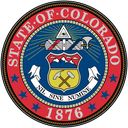 1905: Colorado Good Roads Association was formed in Denver.
1905: Colorado Good Roads Association was formed in Denver.
1909: Colorado State Legislature created the first State Highway Commission. Three members (C.P. Allen of Denver, Thomas Tully of Durango and W.H. Willey of Holly) were appointed to Commission, taking their posts on January 1, 1910. The Commission was charged with responsibility of establishing a network of state primary roads.
1910: C.P. Allen served as the first chairman of Colorado Highway Commission. The city of Denver experimented with various road-surfacing materials along Speer Boulevard.
1910-1920
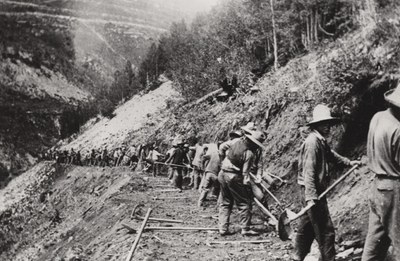 1913: The Colorado General Assembly passed legislation reorganizing the State Highway Commission into the State Highway Department and provided a funding source – vehicle registration fees varying from $2.50 to $10 depending upon the vehicle’s horsepower - to improve the 4,380 miles of a primary road system laid out by the original Highway Commission.
1913: The Colorado General Assembly passed legislation reorganizing the State Highway Commission into the State Highway Department and provided a funding source – vehicle registration fees varying from $2.50 to $10 depending upon the vehicle’s horsepower - to improve the 4,380 miles of a primary road system laid out by the original Highway Commission.
1915: There were 5,844 miles designated on the state highway system. Less than half (approximately 2,600 miles) had been constructed and only 196 miles had been surfaced. More than 200 bridges had been built, primarily by the counties with the assistance and direction of the Colorado Highway Commission.
1916: Passage of the Federal Aid Highway Act provided federal matching funds for state highway projects.
1916: The automobile road over Wolf Creek Pass was opened to traffic.
1917: State Legislature passed the Highway Act reorganizing the Highway Commission into the State Highway Department and creating a State Highway Fund to distribute state and federal funds for the development and maintenance of the state’s highway system.
1918: First concrete pavement laid in the state from Denver to Littleton along Santa Fe Drive (Federal Aid Project/F.A.P-1). The total cost of paving came to $73,939.74.
1919: Colorado was one of four pioneering states to pass a one-cent per gallon gas tax with revenues to be allocated to the state road fund.
1920-1930
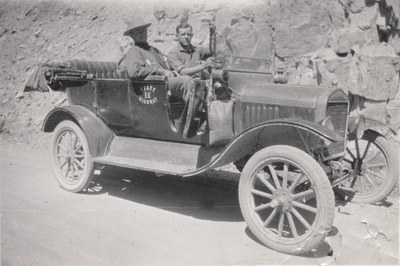 1921: Legislature repealed the four-year-old Highway Act. In May, Major L.D. Blauvelt was appointed as state highway engineer.
1921: Legislature repealed the four-year-old Highway Act. In May, Major L.D. Blauvelt was appointed as state highway engineer.
1921: A Division of Maintenance was established by the Colorado Highway Commission.
1922: The U.S. Bureau of Public Roads approved Colorado’s first federally aided road system covering 3,332 miles.
1924: The highway department completed the “Million Dollar Highway,” today’s US 550, in Southwestern Colorado. The first automobile crossed Independence Pass on a reconstructed route roughly following the old wagon road over Hunter’s Pass on what would later become SH 82.
1927: At the urging of Colorado Governor Clarence J. Morley, the Mt. Evans highway was completed by the highway department and opened for traffic to elevation 14,124’, just below the 14, 264’ summit of the mountain. It is the highest elevation for a paved highway in North America.
1927: The federal government established a modern highway numbering system.
1928: State Highway Department hired 250 maintenance employees and assigned them to 125 locations across Colorado.
1929: The first automobile crossed Loveland Pass on Sept. 29.
1929: The Colorado state highway system had grown to 9,203 miles, of which 4,725 miles were graded and drained, 3,839 miles were gravel, 13 miles were bituminous concrete, and 339 were cement concrete.
1930-1940
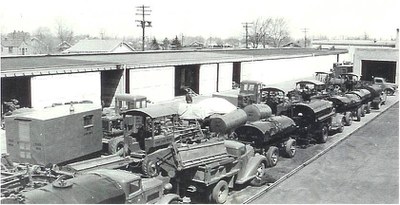 1930: On October 26, Major L.D. Blauvelt died. In December, Charles D. Vail was appointed state highway engineer.
1930: On October 26, Major L.D. Blauvelt died. In December, Charles D. Vail was appointed state highway engineer.
1930s: During of the Great Depression, federal work projects helped Colorado construct and maintain state highway system.
1935: Highway Department employees were joined by 44 new co-workers selected from among 7,500 applicants to become the first members of the Colorado State Highway Courtesy Patrol. The Patrol became a division of the Highway Department.
1938: Colorado expanded the state highway system to nearly 12,000 miles. The road over Berthoud Pass, today’s U.S. Hwy. 40, was completed.
1939: Work on the current Monarch Pass was completed.
1940-1950
1940: The original highway (U.S. Hwy. 6) over Vail Pass was completed.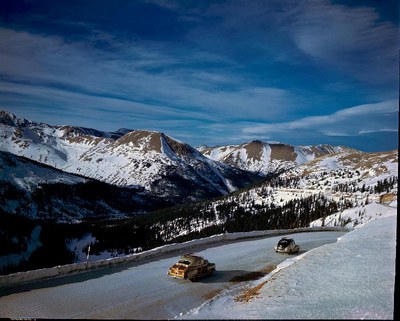
1944: The Federal Highway Act of 1944 authorized route designation and preliminary design of an eventual interstate highway system.
1945: Charles Vail passed away in January.
1946: Mark U. Watrous became the Chief Engineer after surviving a court battle contesting the civil service examination and his appointment.
1947: The first National System of Interstate and Defense Highways was approved by the federal works administrator. In Colorado, approved routes included all of I-25 from the Wyoming border to Raton Pass; all of I-80S (now I-76); and I-70 from Denver to the Kansas border.
1948: Work commenced on Denver’s Valley Highway on the route of what would later become I-25 through the Denver metro area.
1950-1960
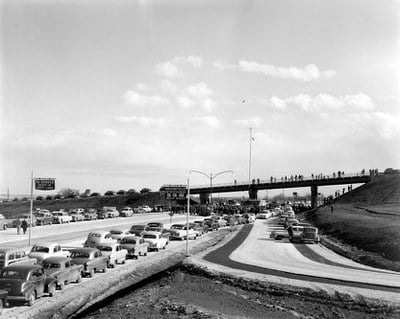 1950: Grading work and ballast on 10.7 miles of the Denver-Boulder Turnpike began.
1950: Grading work and ballast on 10.7 miles of the Denver-Boulder Turnpike began.
1952: The entire Denver-Boulder Turnpike opened to through traffic. The toll for the entire route was 25 cents.
1953: The state legislature passed a new law reorganizing the Highway Department and renaming it the Colorado Department of Highways.
1956: Congress passed the Federal Interstate Highways Act. Among the approvals was the section of I-70 from Denver to the Utah border.
1957: U.S. Bureau of Public Roads approved the I-70 route designation from Denver west to Utah.
1958: The Valley Highway opened through central Denver.
1958: Construction began on I-80S, linking I-80 near Julesburg with I-70 in the Denver area, the two longest interstate highways in the nation. I-80S was renamed I-76 in Colorado’s centennial year of 1976.
1960-1970
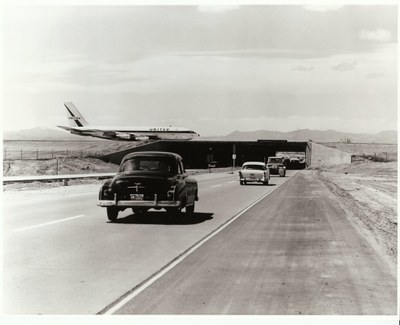 1963: In August, Mark Watrous retired as chief engineer. Governor John A. Love appointed
1963: In August, Mark Watrous retired as chief engineer. Governor John A. Love appointed
Charles E. Shumate to lead the Department of Highways as chief engineer. Initial boring of the westbound Straight Creek tunnel through the Continental Divide along today’s I-70 route began in October.
1964: Federal funding expands the Valley Highway (I-25) and I-70. The first 2.6 mile section of I-70 opened along what is today’s elevated portion from I-25 to the east.
1968: The U.S. Secretary of Agriculture ordered the alignment of Interstate 70 near Vail along the existing U.S. Hwy. 6 route. Department reorganization gives Shumate the title of Executive Director of the Colorado Department of Highways.
1969: The final segment of I-25 in Colorado, 21 miles between Walsenburg and Trinidad, was completed and dedicated.
1970-1980
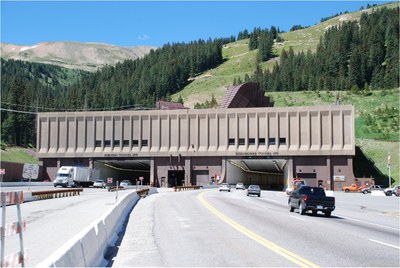 1973: On March 8, the westbound Straight Creek tunnel bore, officially named the Eisenhower Memorial Tunnel, was dedicated.
1973: On March 8, the westbound Straight Creek tunnel bore, officially named the Eisenhower Memorial Tunnel, was dedicated.
1975: Charles Shumate retired as executive director. Jack Kinstlinger appointed his successor.
1976: I-225 opened on the east side of the Denver metro area.
1976: On Colorado Day, the Big Thompson Canyon flood devastates a section of U.S. 34, claiming 145 lives.
1978: On Vail Pass, the Department of Highways dedicated the full four-lane configuration of I-70 after five years of construction.
1979: The eastbound I-70 bore opened through Continental Divide. The tunnel was named in honor of former U.S. Senator and Colorado Governor Edwin C. Johnson. This combined engineering triumph was officially known as the Eisenhower-Johnson Memorial Tunnel complex.
1980-1990
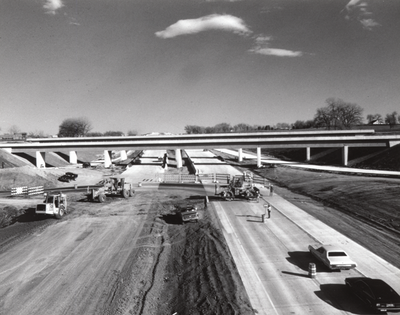 1980: Construction began on the final link of I-70, a 12-mile segment through Glenwood Canyon.
1980: Construction began on the final link of I-70, a 12-mile segment through Glenwood Canyon.
1982: Joseph Dolan was appointed executive director; succeeding Jack Kinstlinger.
1984: An accident on I-25/I-70 interchange, locally known as the Mousetrap, grabbed national attention when a load of torpedoes spilled onto the freeway.
1984: The Colorado State Patrol, a division of the Colorado Department of Highways, was moved to the newly-created Colorado Department of Public Safety, ending a direct relationship with CDOH and its predecessor agencies that began in 1935, when the Colorado State Highway Courtesy Patrol was first formed.
1985-88: Construction of the first three phases of the Centennial Parkway (today’s C-470 route around the southwestern portion of the Denver metro area) got underway.
1987: Work began on reconstruction of I-25/I-70 interchange. Lowell B. Jackson
assumed the executive director’s job succeeding Joseph Dolan. A. Ray Chamberlain succeeded Jackson later that year.
1990-2000
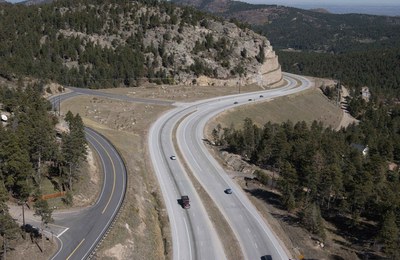 1991: The Colorado Department of Highways becomes Colorado Department of Transportation with passage of the Intermodal Surface Transportation Efficiency Act (ISTEA) by the U.S. Congress.
1991: The Colorado Department of Highways becomes Colorado Department of Transportation with passage of the Intermodal Surface Transportation Efficiency Act (ISTEA) by the U.S. Congress.
1992: The I-70 Final Link, a 12-mile portion of the freeway through Glenwood Canyon, was completed in October. Dedication ceremonies were held in the Hanging Lake Tunnels.
1994: Guillermo V. Vidal was appointed CDOT Executive Director.
1999: Through Transportation Revenue Anticipation Notes (TRANS), Colorado voters allowed CDOT the authority to issue bonds to fund 28 strategic corridor transportation projects, including the $1.67 billion T-REX project, designed to alleviate congestion on southeast Denver interstate corridors. T-REX was Colorado’s largest single transportation project ever constructed.
1999: Thomas E. Norton was appointed CDOT Executive Director.
2000-2010
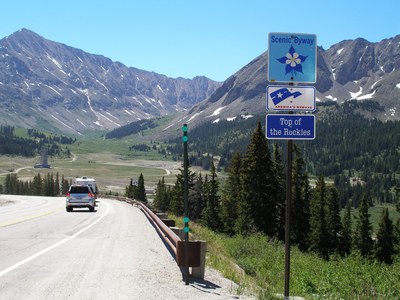 2006: The T-REX project was dedicated and completely opened well ahead of schedule.
2006: The T-REX project was dedicated and completely opened well ahead of schedule.
2007: Russell George was appointed CDOT Executive Director.
2008: The global economic crisis had a strong negative effect on CDOT funding.
2009: The Funding Advancements for Surface Transportation and Economic Recovery (FASTER bill is passed with funds earmarked for bridge repairs and reconstruction. It marked the first dedicated funding increase for CDOT since 1991.
